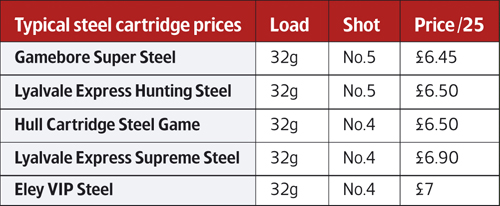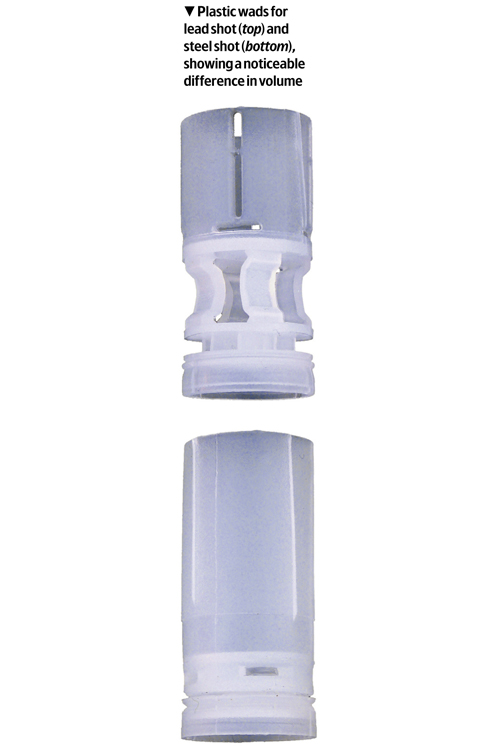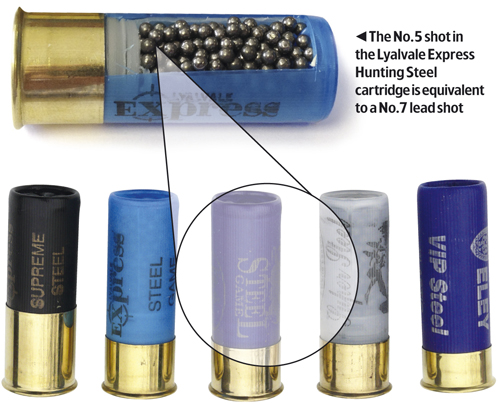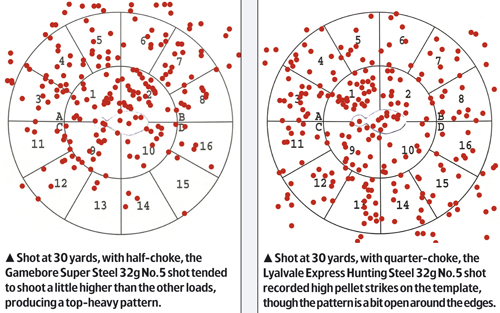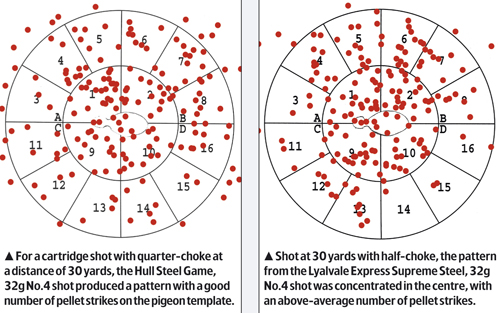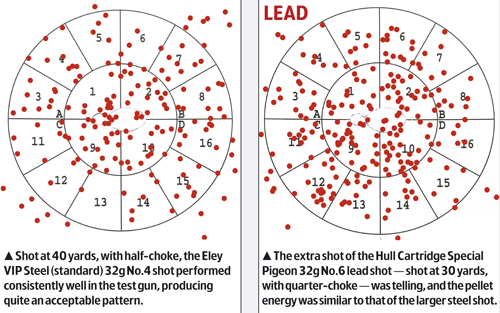Win CENS ProFlex DX5 earplugs worth £1,149 – enter here
Steel shot cartridges review
Steel shot cartridges: Can steel shot be used for pigeon shooting? Lewis Potter tests a variety from his cartridge bag.
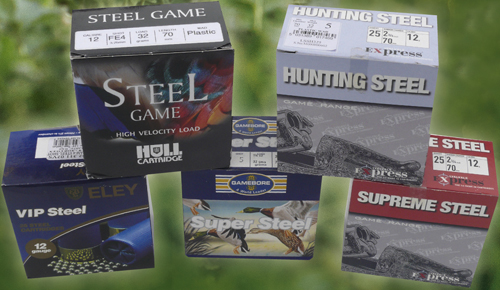
Can steel shot be used for pigeon shooting? Lewis Potter tests a variety from his cartridge bag.
Withdrawal symptoms start to set in by February. The game season has been and gone — all too quickly, it seems — and the last trip for a few elusive duck is a recent memory.
You feel at a loss, but not to worry, there is always that most challenging of sports: pigeon shooting.
Imagine that you have received a phone call telling you pigeon are coming in on to a spring crop, and that you have some cartridges left over from the game season that can be profitably used up.
However, when you delve into your store you find a mixed bag of mainly steel shot cartridges.
Some are game loads, others proclaim their suitability for duck shooting, so what can you do?
Must you rush out and buy more cartridges, or are these suitable for pigeon?
To quote an old friend of mine, you can kill anything with anything under the right circumstances, so it is simply a matter of assessing what we have got and how they might be used.
CARTRIDGES AND LOADS
My hoard of cartridges includes Eley VIP 32g No.4 steel shot (not to be confused with the VIP steel high-performance loads), Gamebore Super Steel 32g No.5 shot, Hull Cartridge Steel Game 32g No.4 shot, Lyalvale Express Hunting Steel 32g No.5 and the same maker’s Supreme Steel with 32g No.4 shot.

The first thing to consider is the shot load, as many shooters might feel that 32g (1.1⁄8oz) is a bit heavier than needed for pigeon shooting, especially if decoying.
However, bear in mind that right back to the days of breech-loading blackpowder, 1.1⁄8oz was a standard load for the 12-bore.
Anything less (usually 28g or 1oz) was a light load and much more suited to a 16-bore.
Very light 12-bore loads are something of a modern trend. More important is the number of pellets to give a good pattern density.
For any given purpose, the steel shot used is bigger to bring it closer to the ballistics of lead shot used for the same type of shooting.
The general rule for steel shot is to go up two sizes so, as both No.6 and No.7 lead shot are used for pigeon, the equivalent steel shot sizes are No.4 and No.5, which is what I have in my modest cache.
Bigger shot means more room is taken up in the cartridge case, so to get that good pattern density, a larger load is needed.
As an example, a 30g load of No.6 lead shot contains about 290 pellets — around the same as 32g of No.4 steel shot.
CHOICE OF GUN
Next we have to think about what gun to use, and if your favourite game gun has Damascus barrels or was proofed prior to 1904, it must stay in the cabinet.
Even with the “reduced” steel loads, which give pressures similar to those from lead shot cartridges, it is wise to have any older gun checked by a gunsmith for its condition and suitability.
Realistically, though, most keen pigeon shooters will be using something more modern, and both over-unders and semi-automatics are favoured for this type of sport.
Such guns (assuming they are in good condition) will handle reduced, sometimes called “standard”, steel loads without any problems — the one advisory for any gun not specifically proofed for steel shot is to use no more than half-choke.
With the latest shotguns, superior proofed for high-performance steel shot, it is best to check with the guidance issued by the manufacturer, but with multi-chokes, they are usually marked with their suitability for either lead or steel.
When decoying, where distances are fairly well controlled, open chokes are the norm, but for high birds there may be limitations on the use of steel shot.
These “reduced” or “standard” steel loads do not have quite the same reach as lead shot — velocity, energy and, therefore, penetration fall off more quickly and the shot pattern starts to fail (at least, that is the theory; as it was, there were a few surprises in store).
SETTING UP FOR TEST
As all the cartridges on test qualified as suitable for any good-condition gun proofed for 1.1⁄8oz and 3.1⁄4ton/in2 (or 850 bar) with 70mm (2.3⁄4in) chambers, I used the same gun for all these tests: the workshop Baikal that had had some work done on the chokes and was known to pattern well with a variety of cartridges through its fixed quarter and half chokes.
One has to remember that, though they may be similar, no two patterns will be exactly the same, and performance will vary from gun to gun — it is simply a case of finding the cartridge that best suits your gun.
Also, the pattern shown on the pattern sheet — in this case, with a superimposed pigeon template — is not exactly representative of that achieved in practice, as the bird is moving and the shot arrives in a slightly elongated shot string, not as the flat disc that might be assumed from the recorded pattern.
Having said that, good patterns and adequate shot energy are still the essential ingredients for the clean kill of what is not a particularly large quarry.
It is worth remembering that bringing a pigeon down is not necessarily the same as a clean kill.
TESTING
Testing included a comparison with a dedicated pigeon load: the Hull Special Pigeon loaded with 32g of No.6 lead shot and using a plastic wad.
This was not just a matter of convenience; that load is known to pattern well in the Baikal.
Testing at 30 yards, a reasonable decoy distance, showed that all the cartridges would give clean kills with both quarter- and half-chokes.
The minimum number of pellet strikes on the pigeon template was six, the most recorded was 11 and the average was eight strikes, all of which should be more than adequate to kill a pigeon.
The difference between the No.5 and No.4 shot loads was not that marked — for example, both the Lyalvale Express Hunting Steel with No.5 shot and Hull Cartridge’s Steel Game with No.4 shot (slightly larger than its lead equivalent) recorded above average pellet strikes on the pigeon template.
The advantage of using half-choke became clear, as it produced a better overall density of pattern.
If the bird was not centered in the pattern, like my pigeon template, there would still be a good number of pellet strikes.
The quarter-choke patterns tended to be a bit more open at the edges, so the chances of multiple pellet strikes would be reduced.
As for the comparison with No.6 lead shot, that had the advantage of an average of 300 pellets in its 32g load so, even with quarter-choke, pattern density was bound to be good.
Also, when comparing equivalent pellet weights, lead is always superior, being smaller and denser.
The Gamebore Super Steel tended to throw patterns a little higher than either the Lyalvale Express or the Hull steel loads.
Of all the steel loads, the Eley VIP was well-suited to the Baikal test gun, and half-choke out to 40 yards still produced good killing patterns.
CONCLUSION
It might seem rather extravagant to use game cartridges for the humble pigeon, but these tests indicate their usefulness should the need arise.
All the steel shot cartridges performed better than expected, especially when using the tighter choke.
In my experience, steel shot can be more sensitive than lead, so checking a particular cartridge patterns well in a certain gun becomes even more important.
As for actual knock-down killing power, that is something one can only try out for real.
Steel shot cartridges review
Related Articles
Get the latest news delivered direct to your door
Subscribe to Shooting Times & Country
Discover the ultimate companion for field sports enthusiasts with Shooting Times & Country Magazine, the UK’s leading weekly publication that has been at the forefront of shooting culture since 1882. Subscribers gain access to expert tips, comprehensive gear reviews, seasonal advice and a vibrant community of like-minded shooters.
Save on shop price when you subscribe with weekly issues featuring in-depth articles on gundog training, exclusive member offers and access to the digital back issue library. A Shooting Times & Country subscription is more than a magazine, don’t just read about the countryside; immerse yourself in its most authoritative and engaging publication.






